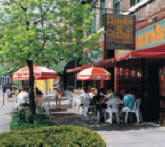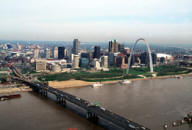| Pierre Laclede Liguest, recipient of a land grant from the
King of France, and his 13-year-old scout, Auguste Chouteau,
selected the site of St. Louis in 1764 as a fur trading post.
Laclede and Chouteau chose the location because it was not
subject to flooding and was near the confluence of the
Mississippi and Missouri Rivers. Construction of a village,
named for Louis IX of France, began the following year. Most of
the early settlers were French; many were associated with the
fur trade. St. Louis transferred to the Spanish in 1770,
returned to France under a secret treaty with Napoleon and,
following the Louisiana Purchase of 1803, became part of the
United States. According to legend, on the day of transfer of
the territory to the United States in 1803, St. Louis flew under
three flags in one day--French, Spanish, and American.
The town gained fame in 1803 as the jumping-off point for the
Louisiana Purchase Expedition of Meriwether Lewis and William
Clark. After 1804, more New Englanders and other East Coast
emigrants settled in St. Louis, but the population remained
predominantly French until well into the 19th-Century. St. Louis
incorporated as a city in 1823. During the 19th-Century, St.
Louis grew into an important center of commerce and trade,
attracting thousands of immigrants eager to find a new life on
the edge of the frontier.
Between 1840 and 1860, the population exploded with the
arrival of many new immigrants. Germans and Irish were the
dominant ethnic groups settling in St. Louis, especially in the
wake of the German Revolution and the Irish Potato Famine. St.
Louis was a strategic location during the American Civil War,
but it stayed firmly under Union control--in large part because
of the fiercely loyal German influence. No major battle was
fought in or near the city, although the "Battle of Camp
Jackson" was a noteworthy skirmish fought on the modern-day
location of the St. Louis University campus. Later waves of St.
Louis settlers included Italians, Serbians, Lebanese, Syrians,
and Greeks, who settled here by the late 19th-Century.
St. Louis's current boundaries were established in 1876, when
voters approved separation from St Louis County and
establishment of a home rule charter. St. Louis was the nation's
first home rule city, but unlike most, it was separated from any
county. Baltimore also is a similarly divided metropolis.
Although this boundary would in the future prove a severe
limitation to the City of St. Louis, at the time there was ample
room for the city to grow within its fixed boundaries. After the
Civil War, St. Louis continued its rapid growth, and by 1900 was
a major manufacturing center. Industries grew in St. Louis
because of the city's dominance in the region, its access to
rail and water transportation, and the city's central location
in the nation. The 1874 construction of the Eads Bridge made St.
Louis an important link in the continuing growth of
transcontinental rail travel--but came too late to prevent
Chicago from overtaking it as the largest rail hub in the
nation. By the 1890s, St. Louis was the nation's fourth largest
city.
One of the City's great moments came in 1904, when it hosted
a World's Fair: the Louisiana Purchase Exposition, in Forest
Park and the city's western edge. The 1904 Olympic games were
also held in St. Louis, at Washington University's Francis
Field, in conjunction with the fair. More than 20 million people
visited the fair during its seven-month run, immortalized in the
song "Meet Me in St. Louie, Louie." Through the early
20th-Century, St. Louis continued to industrialize. The
increasing popularity of the automobile caused congestion in the
downtown area as early as the 1920s. Rapid transit schemes were
proposed but never seriously considered. St. Louis was home to
the nation's first gasoline station and first automobile
accident; today, the region is second in the nation only to the
Detroit area in automobile production. During the Great
Migration, thousands of African-Americans moved to St. Louis
between World War I and World War II. By 1940, over 800,000
people lived in the City of St. Louis.
After World War II, the City's population peaked at 856,000
by 1950. This crowded city had no more room to grow within its
fixed boundaries, and much of the housing stock had been
neglected during the Great Depression of the 1930s and during
World War II. Thus any new growth had to occur in the suburbs in
St. Louis County, which St. Louis could not annex. Although some
African-Americans from the South, as well as Southeast
Missourians, continued to move into St. Louis, earlier immigrant
generations gradually moved to suburbia. Urban renewal efforts
and public housing development programs could not stem the tide
of population loss, and in some cases contributed to the
decline. Four new interstate highways cut block-wide swaths
through neighborhoods, facilitating the exodus to the suburbs.
Meanwhile, the last streetcar line in St. Louis, the Hodiamont,
stopped operating in 1966. In the early 1970s, suburbanization
of the African-American population began. By 1980, the City's
population had fallen to about 450,000.
Yet, the 1965 construction of the Gateway Arch and 1966
construction of Busch Memorial Stadium (home of the Cardinals
baseball team) helped promote the revitalization of the central
business district. A thirty-year downtown building boom
followed, including such projects as the Cervantes Convention
Center in 1978, the Union Station rehab in 1985, and St. Louis
Centre in 1986. At the same time, growing interest in
preservation of historic neighborhoods--partly fueled by Federal
tax credits--led to the revitalization of the Central West End,
DeBaliviere Place, Soulard, and Lafayette Square neighborhoods
during the 1970s and early 1980s.
Although the 1986 tax reform and the recession of the late
1980s and early 1990s slowed growth considerably, several major
projects were completed such as the MetroLink light rail line,
the Convention Center expansion, Kiel Civic Center (home of the
Blues), and Trans World Dome (home of the Rams). The great
Mississippi River flood of 1993 detracted from urban
revitalization efforts somewhat, but most of the low-lying
industrial areas of the City were protected by a floodwall. The
most severe flooding in the City occurred along the River des
Peres, a drainageway serving the western and southern parts of
the City and flowing into the Mississippi River. Today, despite
a continued population decline, downtown and neighborhood
revitalization efforts are ongoing in the City of St. Louis.
Medicine at Barnes-Jewish and St. Louis University Hospitals,
brewing at Anheuser-Busch, and banking at Bank of America and
Firstar Bank are leading industries in the City; five Fortune
500 corporations are headquartered in the City limits, and many
of the older industrial buildings in the City serve as
incubators for small business. Despite the challenges, the City
of St. Louis is ready to grow into its fourth century.
back to top
RELATED LINKS
|



